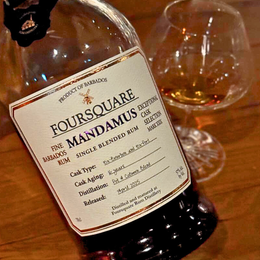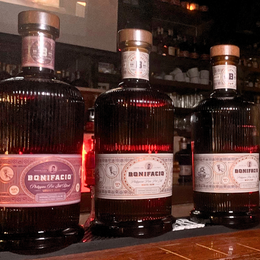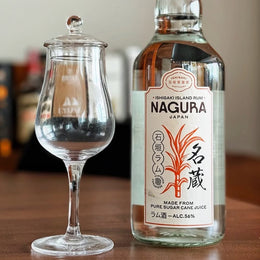
They say not to judge a book by its cover, but if this was book, that cover do be pretty neat! That is all to say, that's one stylish bottle of rum that's going to sit pretty on any shelf or counter top. And something has to be said about the touch and feel of it when you're pouring out a glass that undeniably adds to the experience. But before we get carried away, we ought to get to know what's in this book - sorry, rum - anyway, because this isn't just any rum. This is Zacapa, a key reference in the wide and wild world of rums that you really have to know about. If we're talking must-know or cult classics, you're going to want to pay attention here.

Welcome to Zacapa.
So who is Zacapa?
Zacapa was created in 1976 to commemorate the 100th anniversary of the establishment of the eastern Guatemalan town of Zacapa, which lies some 112 kilometres away from the country's capital. The town itself, whose name derives from Aztec to mean "on the river of grass", has a real sense of being rather historic with its old school charm, and walking around the town's square almost feels like stepping into a portal into the past. Elevated to some 225 metres above sea level, the town boasts little in the way of tourist attractions (although it does offer some artisanal cheeses and cigars), and yet itself remains a critical node for Guatemala - Zacapa sits as the junction for the Guatemala City railroad out from neighbouring El Salvador. Yet it is here that the Botran family had decided to build the Zacapa Distillery.

Introducing The Botran Family
The Botran family plays a prominent role in shaping the spirits distilling scene of Guatemala, borne of five brothers whose parents were of Spanish descent and had immigrated from Spain to Guatemala in the early 1900's. The five Botran brothers had together established the Industria Licorera Quetzalteca (later Industrias Licoreras de Guatemala, or ILG) in the western Guatemalan town of Quetzaltenango in 1939, at a time when rum distilling was largely then a mom-and-pop operation. Their much more structured approach and dedicated effort had thus raised the standards of rum making in Guatemala and has since allowed the country to actively produce rums of an international standing.

The Botran family today.
And so the ensuing decades saw the Botran family focus on producing their namesake rums, which in the Spanish style is better known as rons, which emphasises warm and comforting aromatics of florals and spices, with a lifted and more easy going, smoother texture, rounding out the usual punchiness. This was a big hit domestically and allowed the distillery to grow along the years, till the point of fully integrating their process from sugarcane growing and harvesting, all the way to the making, ageing, and bottling of the rons, with a particular emphasis on the blending process. Taking a page from their Spanish heritage, and also somewhat core to the Central American Spanish style ron flavour profile, the rums are blended into a cuvee using the Solera method.

The Solera system at Zacapa.
Understanding The Sistema Solera
The Solera method is most commonly used in Spain for the making of Sherry fortified wines, where barrels are stacked in layers upon layers, with the oldest wines in barrels on the ground, with each successive layer atop holding younger and younger wines - every time wine is drawn from the barrels in the lower levels, those same barrels are topped up with slightly younger wines from the layer above, almost in a sort of waterfall cascade flow downwards. This helps the wines (or the rums in this case!) marry more harmoniously and achieve an incredibly silky and velvety plush texture and flavours that are practically seamless like nectar. Call it the perpetual cuvee that's never allowed to run dry and is constantly replenished atop its base. Now for added flavour, as Zacapa does, some of these rums are taken out of this Solera system to be aged in more exotic casks, such as barrels once holding Bourbon, Sherry or Cognac. Once these rums have aged and absorbed some of the flavours of these barrels, it is then returned to the Solera system to once again marry with the perpetual reserve, bringing to it more unique flavours. Zacapa calls this Sistema Solera.

The mineral rich volcanic soils prove great for sugarcane harvesting.
Creating Zacapa: From Sugarcane Of The Valleys To Ageing In The Clouds
And so by 1976, with Botran already well-established locally, the family thus expanded into creating Zacapa. If Botran was about the family's heritage in distilling, Zacapa would focus more on expressing its Guatemalan terroir.
And this all starts with extracting what is believed to be the purest form of cane essence - the juice from the first pressing of the Guatemalan sugarcane. Sugarcane is first harvested from the Retalhuleu fields in south Guatemala, where the mineral rich volcanic soil proves highly conducive for growing sugarcane with a depth of flavours. The juices from the first pressing of the cane is then simmered down to a honey like consistency, which Zacapa terms Sugar Cane Honey. Fermentation is done very uniquely with the use of pineapple yeasts, which further adds to the rum's unique flavours. Finally it is distilled using column stills, as is in the Central American practice.

The House Above The Clouds where Zacapa's rums are aged.
But really now comes the showstopper - once distilled, the rums are brought up 2,300 meters above sea level to Zacapa's ageing cellars, this raises the rums above the clouds where they'll age amidst the cooler and more humid ambient environment. Zacapa has a rather romantic name for an equally romantic setting for its ageing cellars - the House Above The Clouds. Here in highlands of Quetzaltenango of western Guatemala, the rums spend years in the fresh mountain air, married gently with the Sistema Solera method under the mindful watch of Master Blender Lorena Vasquez. Just to add to that sense of provenance, Zacapa's classic bottles come with a nice little touch of Guatemalan craftsmanship, in the form of a handwoven petate band that adorns the bottle - now this used to cover the entire bottle in the early days, but has since been thickened and streamlined to a band around the base of the bottle that's alot more stylish and modern.

The Zacapa XO
And so with all that said, today we're going to be trying Zacapa Centenario XO Solera Gran Reserva Especial (which for short, you can just call the Zacapa XO)!
The Zacapa XO is a cuvee of rums aged between 10 and 25 years old via the Sistem Solera method as detailed above. Yet here, beyond the classic barrels Zacapa typically uses, including American whiskey barrels and Sherry barrels (including Pedro Ximenez and Oloroso), the XO includes specially the use of French oak ex-Cognac casks in the mix. This is bottled at 40% ABV.
Let's give it a taste!
PS. Zacapa joined the Diageo fold in 2011 and has since seen much greater international distribution - and now it's Singapore's turn! So if you're in the little red dot keep your eyes peeled for more in the way of Zacapa making a bigger showing here.
Rum Review: Ron Zacapa Centenario XO Solera Gran Reserva Especial

Tasting Notes
Colour: Dark Mahogany
Aroma: Really rich and heady, it's deep into all those darker tones of brown sugar, swaths of treacle, chocolate shavings, outlined by by some orange zest, and coming together to give some chocolate coated orangettes. It's supported by some firm oak, bringing on a light dusting of oak spices of nutmeg and cinnamon, along with some brighter tones of vanilla sauce. There's an earthiness to it as well, of tobacco and coffee, some nuttiness of marzipan, and a savouriness of creme brulee crust and burnt brown sugar. With time those more perfumed aromatics recede to allow more fruits to come through, at the top there's dried apricots and raisins, and towards the base more on dried prunes and stewed figs.
Taste: It gets off to a nice punchiness with a really rich and fuller body, somewhat syrupy and very rounded. That initial bit comes with this really aromatic spiced quality of nutmeg, cloves, cinnamon and cardamom, almost chai like, with some fine woodiness, which then develops into a darker yet still very aromatic earthiness of mocha, chocolate shavings and coffee. It's backed up by Demerara brown sugars and creme brulee crust, with that same brighter tones of orange blossoms, dried apricots and yellow raisins. It's incredibly silky and seamless, velvety even, with the flavours weaved together harmoniously. It demonstrates great balance too, with the spices, earthiness, sweetness and fruits all finely calibrated to deliver something whole and complete. Towards the core there's a slight nuttiness of toasted almonds and also more in the way of stewed plums and figs, almost like a plum tarte, with some candied ginger as well. It's rich and with a nice weight and depth to the body.
Finish: That richness of brown sugar, coffee and chocolate carries into the finish, with some fragrant vanilla as well. Those chai spices stay present yet gentler here, nutmeg, cloves, cinnamon and cardamom, joined by some hazelnut nougat and chocolate hazelnut brittle. Some candied fruits come through as well, with some chocolate coated raisins and dried apricots. Orange blossoms stay on the finish.

My Thoughts
In the leagues of Central American rums, this is definitely a contender for being amongst the best purely on the basis of taste - it's incredibly enjoyable to drink. Stylistically, it demonstrates a beyond ordinary balance, richness and completeness. Sipping it takes you right into the leatherbound armchairs of a cigar lounge somewhere in the romantic and eclectic towns of South America - it's coloured largely by earthiness and sensual darker tones of dried fruit, candied nuts, burnt confectionaries and chai spices. Yet what is most impressive here is as mentioned that completeness and balance, the flavours are completely harmonious and seamlessly bounded, with no flavour dominating over another, it's never overly sweet not too burnt and bitter - it's remarkably well composed and offers such richness in its tasting. For what it is, this is uncomplicated and easy to enjoy, as opposed to being a more challenging rum that you'd have to philosophise over or scratch your head figuring out its merits.
It's stylish and refined, yet approachable and a total crowdpleaser.
Kanpai!

@111hotpot







